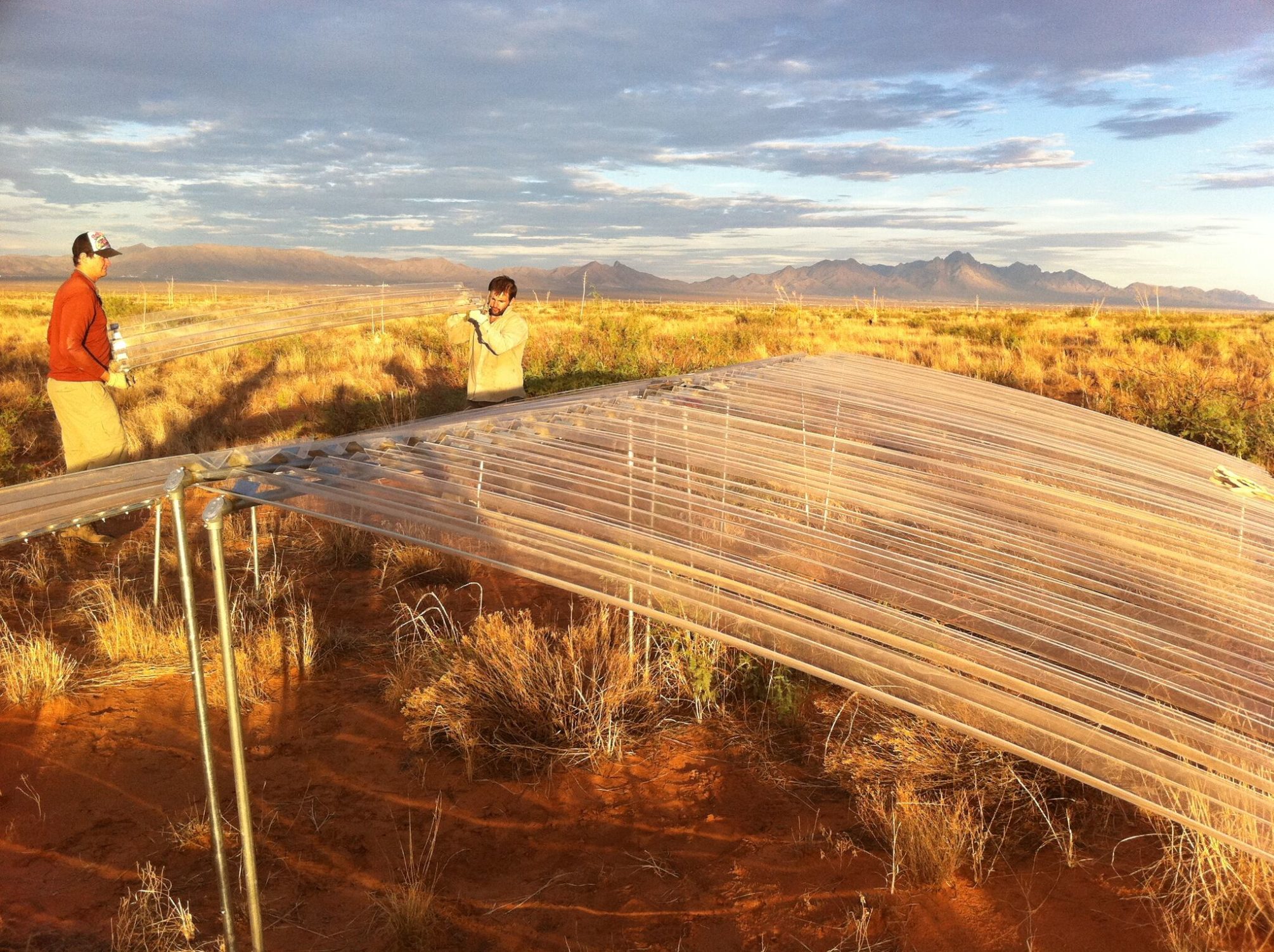
JRN LTER researchers prepare a precipitation addition/reduction experiment.
Credit: US LTER
Background and plans
Many global change drivers (GCDs) lead to chronic alterations in resource availability. As communities change through time in response to these GCDs, the magnitude and direction of ecosystem responses are also predicted to change in a non-linear fashion. We proposed to examine whether plant community dynamics are predictive of shifts in ecosystem function across 106 long term resource manipulation experiments (including 32 LTER experiments) using the CoRRE database, which was assembled by Komatsu and Avolio with previous LTER and SESYNC funding. Our working group was structured around three main objectives:
- identify temporal patterns of plant community change in response to global change manipulations,
- link these patterns of community change to changes in aboveground net primary productivity and carbon storage, and
- increase dialog between ecological empiricists and modelers to work towards incorporating community change into land-surface models.
Expanded ambitions
Throughout the working group, our primary goals remained fixed. However, several additional paths of inquiry were added as working group members encountered interesting patterns in the data. As a result, while we initially envisioned three publications from this working group addressing each of our three main goals, we now have three papers published, two in review, and eight in preparation. These papers examine topics including tradeoffs among species responses to various GCDs, background rates of community change, in-depth examinations of the factors underlying community change in response to GCDs, patterns of variability in community change across space, and how GCDs alter ecosystem stability.

Structure and process
Our working group was structured into three primary meetings and several secondary meetings. Our primary meetings were organized such that the first focused on statistically analyzing the CoRRE database to identify patterns of community and ecosystem responses to experimentally imposed global change drivers; the second brought together both empiricists and modelers for discussion related to incorporating grassland dynamics and community change into land surface models; and the third focused on identifying specific ways in which land surface models could be improved going forward. Across these three primary meetings, the working group members varied based on the expertise needed for each objective. In between the primary meetings, we held small writing meetings with the lead authors of the products we were trying to push toward completion. Moving forward, Avolio and Komatsu have received funding from sDiv to delve into a new aspect of the CoRRE database, to examine how plant traits and phylogeny may predict community responses to GCDs.
Lessons learned
We consider our discussion between empiricists and modelers on how GCDs’ effects on communities and ecosystems can be incorporated into land surface models to be one of the biggest successes of our working group. Much of the three-day meeting was spent helping both groups develop a firm grasp on the terminology and methodology of each other. Yet, once this was achieved, we discovered many commonalities in scientific goals across the two groups. Although getting two very different subfields of ecology together was quite challenging, we think that all future working groups would benefit from structuring their meetings in a way that enables working group members to quickly get on the same page, including pre-meeting readings and large group discussions. Additionally, budgeting for small, in-person writing meetings with a subset of working group participants and scheduling bi-weekly virtual meetings for pushing products forward is a great way to keep working groups on track. On a lighter note, we also found the Escape Rooms in Santa Barbara to be a fun after-hours activity for team building!
By Kimberly Komatsu (formerly La Pierre), Meghan Avolio, and Kevin Wilcox
Lead PIs, Communities to Ecosystems (C2E) LTER Working Group
Products to date:
Komatsu, KJ, Avolio, ML, Lemoine, NP, et al. 2019. Global change effects on plant communities are magnified by time and the number of global change factors imposed. PNAS.
Langley, JA, Chapman, SK, La Pierre, KJ, et al. 2018. Ambient changes exceed treatment effects on plant species abundance in global change experiments. Global Change Biology.
Avolio, ML, Carroll, I, Collins, SL, et al. 2019. Metrics for analyzing community changes based on changes in rank abundance curves. Ecosphere (in press).
Avolio, ML, Wilcox, KR, La Pierre, KJ, et al. Global change drivers diminish differences in variability of aboveground net primary production across herbaceous-dominated ecosystems. Global Change Biology (in review).
Wilcox, KR, Komatsu, KJ, Avolio, ML, C2E Consortium. Improving collaborations between empiricists and modelers, ecologists and biogeophysicists to advance grassland community dynamics in ecosystem models. New Phytologist (in review).










